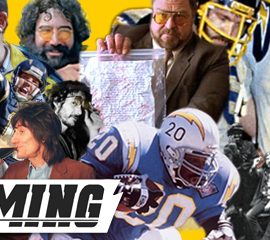The death of Junior Seau didn’t come entirely as a shock. His 2010 “incident,” which ended with him driving his SUV off a cliff, began with allegations of domestic abuse brought by an unnamed 25-year old woman. It was a far cry from OJ, but it was a little seamy for a guy who been a god in San Diego. He had at one time been “happily” married and he and his wife Gina even appeared in a photo shoot for Sports Illustrated. As I recall, it was one of those “athletes and their beautiful wives” spreads that the magazine sometimes runs with the swimsuit issue. The intention is undoubtedly to detract from the cries of sexism that accompany the issue every year. However, it also seems to send the message these guys have it all. In Junior’s case, it truly was a magazine fabrication as he was divorced in 2003. When he was next featured in the magazine, along with the rest of the then-undefeated Patriots in 2007, the corresponding profile revealed that he was living by himself in an apartment in Boston while playing for the team.
The day he died, the NFL Network ran some old footage of Junior in a 1991 game against the Jets. He was miked up, and chirping the entire game. It was reminiscent of Lawrence Taylor’s “pack of wild dogs” footage, of which my buddy Mike always reminds me, was filmed during a Jets win. I was at that ’91 game, which the Bolts were blown out of, 24-3. But as the film reveals, Junior not only had his motor going the entire time, but was trying to motivate, coach and console every guy on the defense. Whenever Blair Thomas (#2 pick in the previous year’s draft) carried the ball, Jet fans would shout at him “You could have been Junior Seau!” Even though they hated every draft pick in those days, this actually qualified as their highest praise for an opposing player. Unfortunately, this was actually one of Thomas’ good days, where rushed for 75 yards that day, including a 22-yard touchdown. That’s how bad the Bolts were back then.
Every member of my generation claims to have once fallen in love with the “Air Coryell” Chargers. But by the end of the 1980s, the Bolts were outright abysmal. As a kid from Westchester County, NY who’d sworn to support them, I was starting to seriously question my decision. I finally saw the Bolts in person in 1986, the week after Gary Anderson swan dove into the end zone against Miami. They were promptly destroyed by the Giants, the far worse of the two local teams at the time, but who would go onto win their first Super Bowl that season. The following year, the Bolts won all 3 of their “replacement” games during the players’ strike and started 8-1. I wrote a full-page article about them in my high school newspaper. They lost their next six games and missed the playoffs. I not only took a lot of grief that season from the other kids at school, but privately wondered if my hubris had caused the collapse. I’d later learn all too well that I couldn’t get the Chargers to do anything. I even went as far as to call the late-night talk shows of the pre-WFAN era to vent my frustration. Not surprisingly, I was treated like a bit of an oddity. It wouldn’t be the last time.
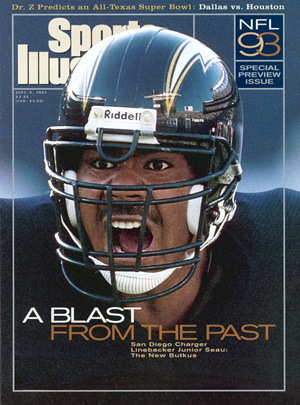
After winning 9 of their next 10 games, the Bolts were actually poised to make the playoffs for the first time. During my winter break, they faced the Raiders in the LA Coliseum. This was the team that had beaten Don Coryell’s team in the 1980AFC Championship game on its own field. This was the team that almost ended Kellen Winslow’s career in 1984. He would recover from the ligaments exploding in his knee, but was no longer the superhuman player he once was. This was the team that broke Dan Fouts’ nose in eight places and gave him a concussion in the same game in 1986. Famously, Fouts played on with blood dripping onto his white jersey. Every team in the AFC West can claim a bitter rivalry with the Raiders. But in the Chargers case, it had been one-sided for quite some time. It was time to settle all debts. The ’92 team was not only good enough to be nationally televised that week, but actually avoided being blacked out in New York, no small task.
Appropriately, Junior had the team’s first tackle that day when he dropped Eric Dickerson for a two-yard loss. He’d often explode into opposing backfields with the eccentric fury of a bottle rocket with the guide stick snapped off. Then he’d spring off the turf and do his signature celebration, a simulation of a lightning bolt striking so hard I thought eventually he’d dislocate his shoulder from the kickback. But on this day, it served as a roundhouse counterpunch. Twenty busloads of Charger fans had made the trip to LA that day and they roared back after Junior pumped his arms towards their seats in the heart of the Coliseum end zone. Boltheads were fighting back as well. Later in the game, he picked off a pass and lifted the ball over his head as he returned it. At that moment, it seemed like he was signaling to Al Davis that we were finally sticking up for ourselves. When he threw the ball into the crowd, it felt like a catharsis for all Charger fans. After shutting out Kansas City at home on a wet field in San Diego, the Bolts’ playoff run ended during a monsoon in Miami. On a day where Stan Humphries threw four interceptions and the team was beaten 31-0, Seau was undeterred. He seemingly made every tackle that day, although I think it he was officially credited with 18 solos and five assists. I can still see him, filled with frustration, face down in the mud after trying to make yet another play.
So much has been written about Junior being a local legend, cemented by his multi-sport career at Oceanside high school. Always living 3,000 miles from San Diego, I never got to share in the sense of joyous community that his superstar status fostered. But what I found amazing was that he wanted to play for his hometown team at a time when no one else did. When they had been good, everyone knew the Chargers as an offensive juggernaut with a defense that kept them from reaching, let alone winning, a Super Bowl. With Junior Seau, the Chargers finally had a defender who could kick sand in someone else’s face for a change. In 1993, he appeared on the cover of SI’s NFL Preview as “The New Butkus.” His eyes shot lasers from the glossy page as he barked out defensive signals. The cover called him “A Blast From The Past,” but he was a brand new type of defender for the Chargers. Plus, his was the only the jersey you could buy outside the state of California. It was also the only one you could wear without being laughed at. Like Michael Jordan, he was so good that it was worn by people who didn’t even like the Chargers. Nike clearly perceived that, as they created a great TV spot with Dennis Hopper worshipping his footprint in the sand.
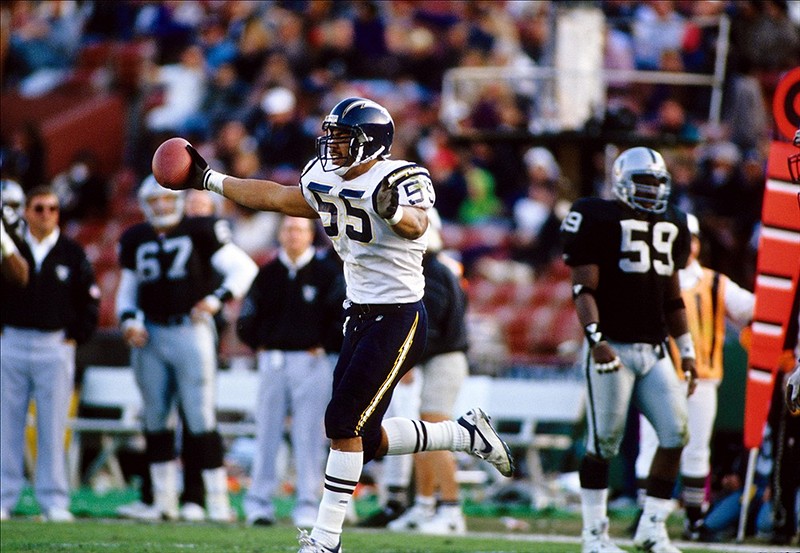
The Bolts took a 37-34 lead in the fourth quarter only to watch as Elway drove down the field and Denver appeared to be launching its own comeback. But somehow, as he was getting ready to throw what would undoubtedly be the winning touchdown, the ball slipped out of his hands and fluttered harmlessly through the air. Seau grabbed it, stayed in bounds and suddenly the game was over. He then ran out onto what remained of the Rockies’ infield and spiked the ball to signal that something special was coming that season. After the game, Junior said that the only way to keep him from coming down with the ball was to chop his hands off. After that game, I took the New York Times blurb from their NFL preview that preceded the game and tacked it up to my office cubicle next to the aforementioned ’93 SI cover. The Chargers predicted 4th place finish also had Junior Seau pictured. Whether the press was good or bad, you couldn’t talk about the Chargers without mentioning him. His identify was indistinguishable from the team’s and vice versa.
Junior Seau’s most Herculean accomplishment was clearly playing the 1994 AFC Championship game with a pinched nerve that had been plaguing him since Week 11. He never talked about it, but on this day it had gotten so bad that he couldn’t lift his left arm above his head. It basically just dangled lifelessly from his shoulder socket. But I’m sure you know that by now since countless articles have been written over the last week about the “curse of the ’94 Chargers.” Back then, however, they hardly felt like a group that was marked for death, quite to the contrary. While I was still at my first job after college and hardly flush with money, I flew to Pittsburgh in the hope that the Bolts could finally reach to the Super Bowl. Junior Seau made me believe that it could actually happen, even if no one else seemed to share my feeling.
In retrospect, they had good reason to be skeptical. The Steelers had blown out the Browns the week before and their fans were poised to watch them capture the AFC for the first time since the Chuck Noll years. Jeff Daniels, in the commercials leading up to his Saturday Night Live appearance the night before, advised viewers to “take the Steelers and the points.” They were favored by 8 ½, although most people didn’t think it would even be that close. After the Bolts fell behind 10-0 at halftime, the PA announcer at Three Rivers broadcast that should the Steelers win, the Rooney family would receive the Lamar Hunt trophy at midfield.
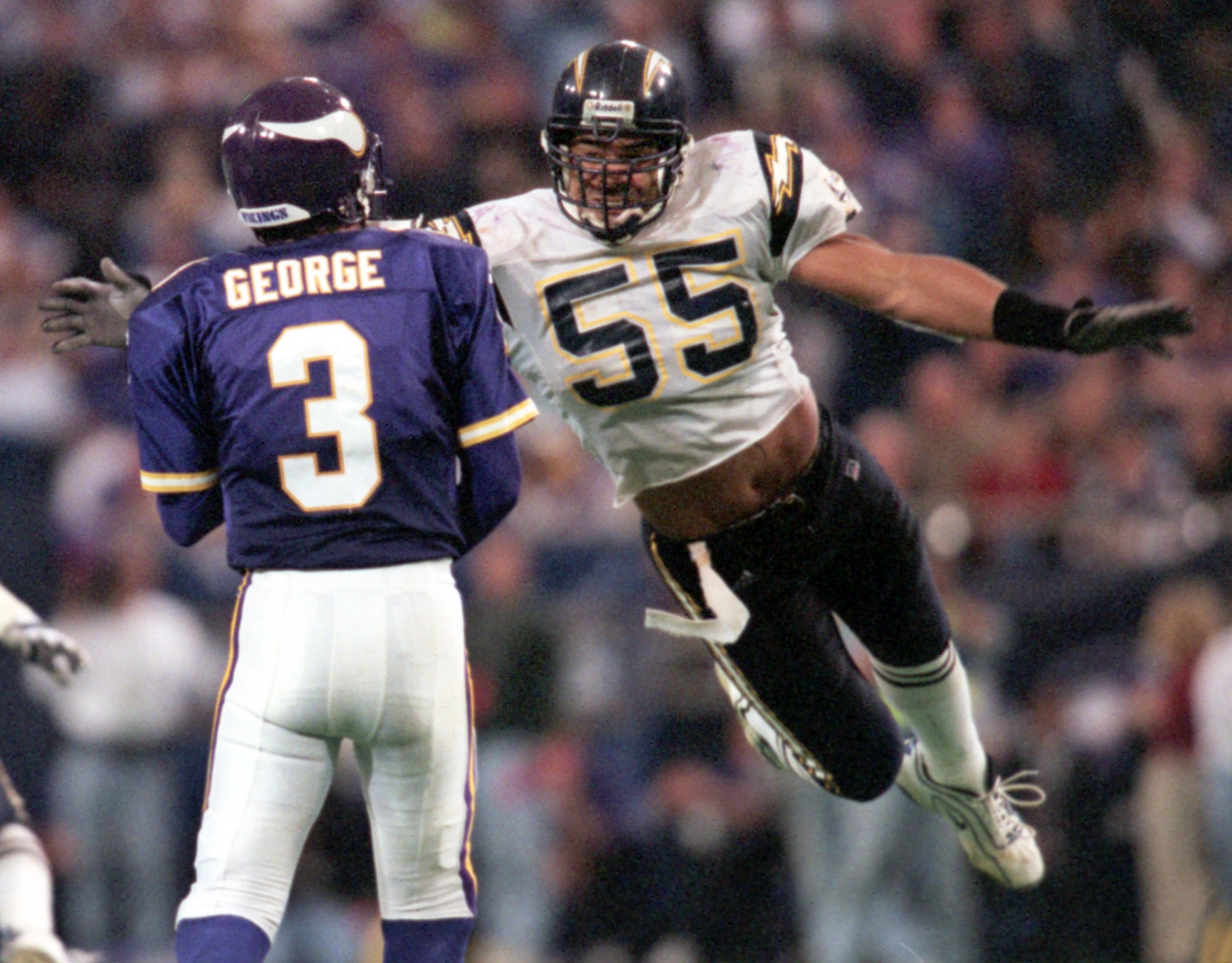
When things got bad again the late 90s, Junior never wilted. He famously stole Ryan Leaf’s credit card to pay for the team’s rookie initiation/dinner for the veterans in 1998. When Leaf went to the front office to complain, Seau leveled him on the practice field. It was as if he discovered first what we would all find out later about Leaf and meted out the necessary punishment immediately. After being unceremoniously traded to Miami in 2003, the same year Rodney Harrison was released, Seau came back to the Chargers to “graduate” in 2006. The prodigal son had returned to retire, it seemed, and the team gave him a big sendoff. However, Bill Belichick called shortly thereafter and Junior joined Rodney in Foxboro in search of that elusive Super Bowl ring. It was a business arrangement, I rationalized, even though the Patriots and their fans immediately fell in love with his infectious style. On day that Philip Rivers valiantly played without an ACL, it was Junior Seau’s shooting the gap on a crucial 3rd and goal that not only kept Michael Turner out of the end zone, but the Chargers from advancing from the Super Bowl, after they returned to the AFC title game in 2007. Of course, Eli Manning, who famously spurned the Chargers and forced a draft-day trade to the Giants in 2004, put an end to Junior’s dream of finally winning a world championship.
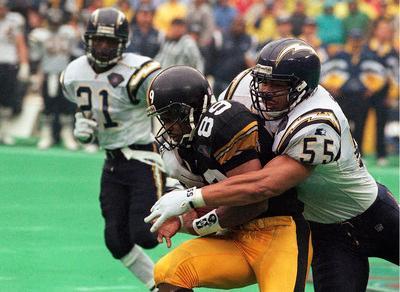
He made the Pro Bowl 12 straight times in San Diego. During many of those years, he was the only Charger to be selected by a long shot. Those games represented the only February football Junior would get to play. There’s a great picture on the web, courtesy of Getty, of him chasing down Jerome Bettis when the former player was still with the Rams. The intensity in Junior’s eyes is staggering, especially when you consider the seemingly meaningless game in which he was playing. We can only imagine how Seau would react to the possibility of the game being abolished in the near future.
His memorial in San Diego, which culminated with his jersey being officially retired by the Chargers, reminded me of what the current team is missing. The Bolts need to discover their soul and play with it. Bobby Ross’ home-spun yarns allowed me to forget the robot we are apparently eternally stuck with as coach. Dan Fouts was the one person who dared temper the “celebration” of Juinor’s life with the reminder that his suicide was a tragedy. What else did you expect from a guy who deservedly referred to himself as “Motherfucker In Charge?” LaDainian Tomlinson returned from his exile with the Jets, resplendent in a powder blue sweater, to thank Junior’s parents for the joy he instilled in everyone he touched. As great and resilient as Philip Rivers and Antonio Gates are, the Chargers and their fans need someone to once again stand up for them. Shawne Merriman once pledged to be “better than Seau,” but he was just a steroid/supplement-fueled mirage. Regardless, I don’t there’s another Junior Seau hanging around to save us.
I won’t speculate as to what caused Junior to take his own life. Beyond his car crash, his behavior seemed more than a bit erratic in recent years. His induction to the Chargers Hall of Fame, which was also been on an infinite loop on sports television, occurred at halftime of their sixth straight loss. On a day when they would lose both the game and division to Tim Tebow and the Broncos, the home crowd understandably was calling for the heads of their coach, GM and owner simultaneously. Sensing the hostility, Junior decided to end his acceptance speech by yelling “SPANOS!” repeatedly. It wasn’t exactly a case of taking the crowd’s mood into consideration.
After Junior’s death, I pulled out my 1994 Super Bowl media guide out from the basement. Even though the quotes in it were undoubtedly culled together even more hastily than publicity materials usually are, I found some interesting words from him. “I take this game very seriously on the field, but it should also be fun. The game started off as a game, playing it in the street. For me, once the fun is gone, so is Junior Seau.” All we know for sure is that the fun was gone for him beyond the game he loved. I don’t know if that’s why he’s gone. I do know that the joy he brought and the pride he instilled in teammates and fans will be sorely missed.
Add The Sports Daily to your Google News Feed!



